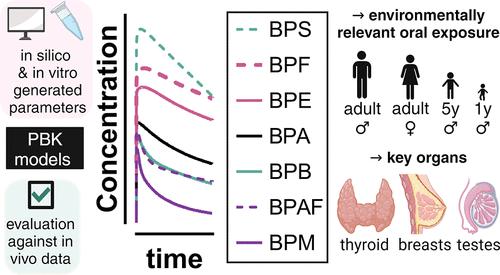基于多模态参数化的生理动力学模型预测双酚A和六种数据贫乏的类似物的人体内部暴露
IF 11.3
1区 环境科学与生态学
Q1 ENGINEERING, ENVIRONMENTAL
引用次数: 0
摘要
双酚(BP) AF、B、E、F、M和S越来越多地被用作双酚A (BPA)的替代品。尽管有广泛的接触和潜在的不良健康后果,但在毒性动力学方面,即它们的吸收、分布、代谢和排泄方面,人们知之甚少。因此,我们为不同的人体生理标准开发了基于生理学的动力学模型,以预测口服暴露后常见双酚类物质的内部浓度。为了解决这些化学物质之间现有人体数据的不平衡,我们使用了多模态参数化方法,包括体外代谢测量、胃肠道吸收的计算预测和大鼠-人肠肝循环的外推。然后,根据现有的BPA和BPS的人体毒物动力学数据对模型进行评估,结果显示,66%的预测Cmax、tmax和AUC值与体内测量值的差异在2倍之内。使用与环境相关的暴露水平来比较所有测试的双酚的内部水平,我们观察到毒物动力学谱的显着差异。在有毒理学关注的组织中,BPS在血液和睾丸中浓度最高,而BPM在甲状腺中积聚,BPAF在乳房中积聚。目前的模型有望促进对双酚a类似物引起的健康风险进行更精确的评估,指导其更安全的使用。本文章由计算机程序翻译,如有差异,请以英文原文为准。

Human Internal Exposures of Bisphenol A and Six Data-Poor Analogs Predicted by Physiologically Based Kinetic Models with Multimodal Parametrization
Bisphenols (BP) AF, B, E, F, M, and S are increasingly used as bisphenol A (BPA) substitutes. Despite widespread exposure and potential adverse health outcomes, they are poorly understood in terms of toxicokinetics, i.e., their absorption, distribution, metabolism, and excretion. We thus developed physiologically based kinetic models for different human physiological standards to predict internal concentrations of prevalent bisphenols following oral exposure. To address the imbalances in available human data among these chemicals, we used multimodal parametrization methods, including in vitro measurements of metabolism, computational prediction of gastrointestinal absorption, and rat–human extrapolation of enterohepatic circulation. Then, the models were evaluated against available human toxicokinetic data for BPA and BPS, revealing that 66% of predicted Cmax, tmax, and AUC values fell within a 2-fold difference from in vivo measures. Using environmentally relevant exposure levels to compare internal levels of all tested bisphenols, we observed significant differences in the toxicokinetic profiles. Concerning tissues of toxicological concern, BPS had the highest concentration in blood and testes, while BPM accumulated in the thyroid and BPAF in the breasts. The present models are expected to facilitate a more precise evaluation of health risks induced by BPA analogs, guiding their safer use.
求助全文
通过发布文献求助,成功后即可免费获取论文全文。
去求助
来源期刊

环境科学与技术
环境科学-工程:环境
CiteScore
17.50
自引率
9.60%
发文量
12359
审稿时长
2.8 months
期刊介绍:
Environmental Science & Technology (ES&T) is a co-sponsored academic and technical magazine by the Hubei Provincial Environmental Protection Bureau and the Hubei Provincial Academy of Environmental Sciences.
Environmental Science & Technology (ES&T) holds the status of Chinese core journals, scientific papers source journals of China, Chinese Science Citation Database source journals, and Chinese Academic Journal Comprehensive Evaluation Database source journals. This publication focuses on the academic field of environmental protection, featuring articles related to environmental protection and technical advancements.
 求助内容:
求助内容: 应助结果提醒方式:
应助结果提醒方式:


